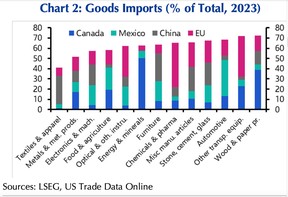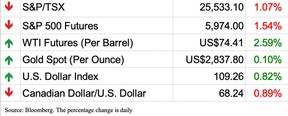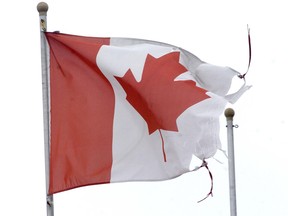Economists are adjusting forecasts in wake of Donald Trump’s tariffs — and it looks grim
Article content

Article content
Article content
The hammer has fallen and Canada now faces its biggest trade shock in nearly 100 years, say economists who rushed to adjust their forecasts this weekend.
Saturday United States President Donald Trump signed executive orders imposing a 25 per cent tariff on all Canadian goods and 10 per cent on Canadian energy. Duties were also levied against Mexico and China.
Advertisement 2
Article content
The tariffs are set to take effect at 12:01 a.m. Tuesday morning and Canada plans to retaliate with levies on $155 billion worth of American-made products. Prime Minister Justin Trudeau is expected to speak with President Trump today.
If the tariffs come down as planned, Canada will suffer a trade shock on the magnitude of the Smoot-Hawley tariffs of the 1930s, which were blamed for prolonging the Great Depression, said economists with Royal Bank of Canada.
There are still a lot of unknowns, and a big one is how long the tariffs will last.
If sustained, the tariffs could wipe out growth for up to three years, said RBC chief economist Frances Donald and assistant chief economist Nathan Janzen. Their estimates, like the Bank of Canada’s, predict that a 25 per cent increase in tariffs across the board in the U.S. and globally would cut Canadian GDP by between 3.4 and 4.2 percentage points.
“Trump’s tariff hammer will come down hard on Canada’s economy,” said Douglas Porter, chief economist at BMO Capital Markets.
BMO assumes the tariffs will be in place for a year, reducing GDP growth by 2 percentage points to “roughly zero” in 2025 and pulling the economy into a mild recession.
Article content
Advertisement 3
Article content
Canadian exports to the U.S. account for about a fifth of GDP. Reduced demand for these exports, disrupted supply chains and heightened uncertainty that reduces business investment will all have an impact on growth.
Domestic demand will also fall on higher prices from Canada’s retaliatory tariffs and a weaker Canadian dollar, he said.
The trouble is the tariffs will hit an economy that was already struggling, said the RBC economists. Canada is still recovering from higher interest rates and the economy is operating below capacity. GDP per capita has declined for eight of the past nine quarters and business investment has been stagnant.
“Canada’s economy is not well positioned to absorb a shock of this scale,” they said.
RBC expects the extra blow of tariffs could push the unemployment rate up by two to three percentage points.
This new reality has also prompted economists to adjust their forecasts for the Bank of Canada, which faces a challenge because tariffs raise prices while slowing growth.
BMO previously expected Canada’s central bank to cut its rate twice more in April and July to 2.5 per cent. Now it expects a 25-basis-point cut at every meeting until October, bringing the rate to 1.5 per cent.
Advertisement 4
Article content
“The net risk is that we get to the endpoint sooner,” said Porter.
This will widen the gap between Bank of Canada and Federal Reserve rates and put more pressure on the Canadian dollar. BMO expects the loonie to average around 67.11 cents U.S. by the fall of this year, but doesn’t rule out it falling further to 66.66 cents U.S.
Toronto Dominion economists say they wouldn’t be surprised if the currency fell to 65 cents U.S.
However, the impact of Trump’s tariff thrust Saturday goes beyond Mexico, Canada and China.
The tariffs are “just the first strike in what could become a very destructive global trade war,” said Paul Ashworth of Capital Economics.
“Trump’s determination to force through substantial tariffs on supposed allies less than two weeks after taking office, and despite the opposition of some moderates within his administration, is a clear indication that the gloves are off this time.”
Trump said Sunday the European Union would be the next target, calling the block an “atrocity” on trade. This morning European stocks were falling as investors braced for the impact.
Advertisement 5
Article content
“How far this goes now is anyone’s guess,” said Ashworth. “But the effective tariff rate on all U.S. imports is already now up to around 10 per cent, for the first time in more than 75 years, with plenty more to come.”
Sign up here to get Posthaste delivered straight to your inbox.


“Trump’s tariffs on Mexico and Canada will make your life more expensive,” Congressman Greg Stanton, an Arizona Democrat, told Americans on a post on X after the President signed executive orders imposing the 25 per cent levies Saturday.
Canada, China and Mexico accounted for 43 per cent or US$1.3 trillion of the US$3.1 trillion worth of goods imported into the United States in 2023, said Capital Economics, whose chart shows the breakdown.
The value of Canadian imports was US$419 billion, of which US$124 billion was energy and minerals. Today’s chart shows the breakdown of those imports in the United States.
Capital says the impact of Saturday’s announcement is already about three to four times the size of tariffs imposed on China in Trump’s first term.
If more tariffs are imposed on goods from the European Union and a universal tariff, inflation in the U.S. will climb back to 3 per cent this year, said Ashworth, Capital’s chief North America economist.
Advertisement 6
Article content
“Any chance of more interest rate cuts this year just died,” he said.

- Today’s Data: United States ISM manufacturing, construction spending
- Earnings: TMX Group Ltd., Tyson Foods Inc.




As equity investors stare down the barrel of China’s surprise impact on U.S. technology stocks with its DeepSeek artificial intelligence model, now is a good time to look at how to handle inevitable market corrections in your long-term investing journey. Julie Cazzin explains how market declines can be an opportunity if you’re playing the long game.
Calling Canadian families with younger kids or teens: Whether it’s budgeting, spending, investing, paying off debt, or just paying the bills, does your family have any financial resolutions for the coming year? Let us know at wealth@postmedia.com.
McLister on mortgages
Want to learn more about mortgages? Mortgage strategist Robert McLister’s Financial Post column can help navigate the complex sector, from the latest trends to financing opportunities you won’t want to miss. Plus check his mortgage rate page for Canada’s lowest national mortgage rates, updated daily.
Advertisement 7
Article content
Financial Post on YouTube
Visit the Financial Post’s YouTube channel for interviews with Canada’s leading experts in business, economics, housing, the energy sector and more.
Today’s Posthaste was written by Pamela Heaven, with additional reporting from Financial Post staff, The Canadian Press and Bloomberg.
Have a story idea, pitch, embargoed report, or a suggestion for this newsletter? Email us at posthaste@postmedia.com.
Recommended from Editorial
-

Trump tariffs not all that’s muddying interest rate waters
-

What record change in ‘age pyramid’ means for the economy
-

Trump’s tariffs echo failed American trade policy in 1930s
Bookmark our website and support our journalism: Don’t miss the business news you need to know — add financialpost.com to your bookmarks and sign up for our newsletters here
Article content
Donald Trump’s tariffs could throw Canada into recession
2025-02-03 13:03:46







